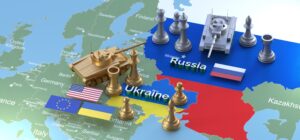
Photo courtesy: Murat Gocmen – Adobe Stock
In 1949, the North Atlantic Treaty Organization (NATO) was formed by the United States, Canada and several other European nations. This alliance was formed to collectively provide security against the Soviet Union.
In 1991, the Ukrainian people voted for independence, shortly after the fall of the Soviet Union. Three years later Ukraine agreed to hand over all of its nuclear weapons to Russia, becoming a non-nuclear power. In return, the United States, the United Kingdom and Russia signed a document called the Budapest Memorandum. This document grants Ukraine security assurance, therefore, it is a signed agreement for all signatories to come to their aid at a time of aggression.
Although, according to The Washington Post, “The agreement is not an official treaty. It is neither legally binding nor does it carry an enforcement mechanism. And while it provides security assurances, they do not include specific promises with regard to a potential invasion.” A lot of people have taken to social media to agree that the U.S. “needs to mind their business.”
In 2008, NATO had a meeting opening up the conversation of Ukraine joining their alliance. Russian leader Vladimir Putin did not like this. He argued that Ukraine was “not even a real nation-state.” Since the two are neighboring countries, it has also been said that Russia fears Ukraine joining NATO and the U.S. potentially being able to set up troops and weapons on the Ukrainian border, amongst other things.
Just last year Putin deployed troops near the Ukrainian border and threatened that Russians and Ukrainians are “one people.” He said if they are admitted to NATO there will be serious consequences for Ukrainians and whoever interferes.
Here we are in 2022 and many decisions made decades ago are still affecting the world today. So, what does this mean for U.S. citizens?
If we go to war it would lead to an increase in inflation, affecting the economy tremendously. Including a potential stock market crash and a major increase in gas prices. Since President Joe Biden has continued to impose sanctions on Russia, people in the U.S. have already begun to see these changes starting to happen. Democrats will have a hard time winning another election with Biden’s failed attempts to influence Putin not to continue with the invasion. Republicans have already argued that Biden is weak and unfit.
Volodymyr Zelenskyy, President of Ukraine has challenged the efforts of NATO after the Russian invasion.
“We are alone in defending our country,” he said. “Who is ready to give Ukraine a guarantee of joining NATO? Honestly, everyone is afraid.”
As this conflict continues to develop, live updates can be found on CNN, The New York Times and USA Today.